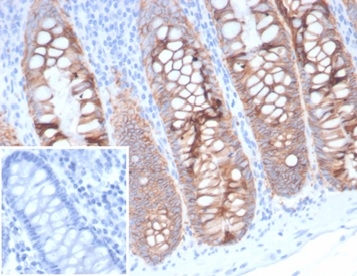EpCAM/TROP1 Antibody (323/A3) - (ECD) - IHC-Prediluted
Novus Biologicals, part of Bio-Techne | Catalog # NBP2-44642

![Immunohistochemistry-Paraffin: EpCAM/TROP1 Antibody (323/A3) - (ECD) - IHC-Prediluted [NBP2-44642] Immunohistochemistry-Paraffin: EpCAM/TROP1 Antibody (323/A3) - (ECD) - IHC-Prediluted [NBP2-44642]](https://resources.bio-techne.com/images/products/EpCAM-TROP1-Antibody-323-A3-IHC-Prediluted-Immunohistochemistry-Paraffin-NBP2-44642-img0001.jpg)
Conjugate
Catalog #
Forumulation
Catalog #
Key Product Details
Species Reactivity
Human, Rat (Negative)
Applications
Immunohistochemistry, Immunohistochemistry-Paraffin
Label
Unconjugated
Antibody Source
Monoclonal Mouse IgG1 kappa Clone # 323/A3
Format
IHC-Prediluted
Concentration
Please see the vial label for concentration. If unlisted please contact technical services.
Product Specifications
Immunogen
MCF-7 human breast cancer cells
Reactivity Notes
Does not react with Rat, Feline or Canine.
Localization
Cell surface
Specificity
EGP40 is a 40-43kDa transmembrane epithelial glycoprotein, also identified as epithelial specific antigen (ESA), or epithelial cellular adhesion molecule (Ep-CAM). It is expressed on baso-lateral cell surface in most simple epithelia and a vast majority of carcinomas. This antibody has been used to distinguish adenocarcinoma from pleural mesothelioma and hepatocellular carcinoma. This antibody is also useful in distinguishing serous carcinomas of the ovary from mesothelioma.
Marker
Epithelial Marker
Clonality
Monoclonal
Host
Mouse
Isotype
IgG1 kappa
Description
The prediluted antibody does not require any mixing, dilution, reconstitution, or titration; the antibody is ready-to-use and optimized for staining.
Scientific Data Images for EpCAM/TROP1 Antibody (323/A3) - (ECD) - IHC-Prediluted
Immunohistochemistry-Paraffin: EpCAM/TROP1 Antibody (323/A3) - (ECD) - IHC-Prediluted [NBP2-44642]
Immunohistochemistry-Paraffin: EpCAM/TROP1 Antibody (323/A3) - IHC-Prediluted [NBP2-44642] - Formalin-fixed, paraffin-embedded Human Colon Carcinoma stained withEp-CAM Mouse Monoclonal Antibody (323/A3).EpCAM/TROP1 Antibody (323/A3) - (ECD)
Formalin-fixed, paraffin-embedded human colon stained with EpCAM/TROP1 antibody (323/A3) - (ECD). Inset: PBS instead of primary antibody; secondary only negative control.Applications for EpCAM/TROP1 Antibody (323/A3) - (ECD) - IHC-Prediluted
Application
Recommended Usage
Immunohistochemistry-Paraffin
0.5 - 1.0 ug/ml
Application Notes
Immunohistochemistry (Formalin-fixed): Staining of formalin-fixed tissues requires heating tissue sections in 10mM Tris with 1mM EDTA, pH 9.0, for 45 min at 95C followed by cooling at RT for 20 minutes.
Formulation, Preparation, and Storage
Purification
Protein A or G purified
Formulation
10 mM PBS with 0.05% BSA
Format
IHC-Prediluted
Preservative
0.05% Sodium Azide
Concentration
Please see the vial label for concentration. If unlisted please contact technical services.
Shipping
The product is shipped with polar packs. Upon receipt, store it immediately at the temperature recommended below.
Stability & Storage
Store at 4C.
Background: EpCAM/TROP1
EpCAM functions as an intracellular signaling molecule and contributes to regulation of epithelial-to-mesenchymal (EMT) transition (4,5). EpCAM is cleaved during the process of regulated intramembrane proteolysis (RIP) (4,5). Initial cleavage occurs at the membrane via a disintegrin and metalloprotease 17 (ADAM17) which releases EpCAM's extracellular domain (EpEx) (4,5). A secondary cleavage is mediated by presenilin 2 (PSEN2) which releases EpCAM's cytoplasmic trail (EpICD) (4,5). EpICD translocates to the nucleus where it associates with beta-catenin, FHL-2, and LEF-1 and induces transcription of genes related to EMT and tumor growth (4,5). EpCAM has also been shown to regulate structure and functionality of the apical junction complex of cells through direct interaction with claudin-7 and association with E-cadherin (2,5). Loss of EpCAM disrupts adherins junction and tight junction structure and function (2).
References
1. Mohtar MA, Syafruddin SE, Nasir SN, Low TY. Revisiting the Roles of Pro-Metastatic EpCAM in Cancer. Biomolecules. 2020; 10(2):255. https://doi.org/10.3390/biom10020255
2. Huang L, Yang Y, Yang F, et al. Functions of EpCAM in physiological processes and diseases (Review). Int J Mol Med. 2018; 42(4):1771-1785. https://doi.org/10.3892/ijmm.2018.3764
3. Brown TC, Sankpal NV, Gillanders WE. Functional Implications of the Dynamic Regulation of EpCAM during Epithelial-to-Mesenchymal Transition. Biomolecules. 2021; 11(7):956. https://doi.org/10.3390/biom11070956
4. Uniprot (P16422)
5. Schnell U, Cirulli V, Giepmans BN. EpCAM: structure and function in health and disease. Biochim Biophys Acta. 2013; 1828(8):1989-2001. https://doi.org/10.1016/j.bbamem.2013.04.018
Long Name
Epithelial Cell Adhesion Molecule
Alternate Names
17-1A, CD326, GA733-2, gp40, KS1/4, M4S1, TACSTD1, TROP1
Gene Symbol
EPCAM
Additional EpCAM/TROP1 Products
Product Documents for EpCAM/TROP1 Antibody (323/A3) - (ECD) - IHC-Prediluted
Product Specific Notices for EpCAM/TROP1 Antibody (323/A3) - (ECD) - IHC-Prediluted
This product is for research use only and is not approved for use in humans or in clinical diagnosis. Primary Antibodies are guaranteed for 1 year from date of receipt.
